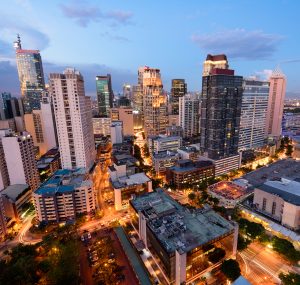Pacific Money | Economy | Southeast Asia
Planners are banking on strong economic growth, reduced inflation, and a strengthening peso in 2023. But are these assumptions sound?

The skyline of Makati, Metro Manila’s financial district, by night.
Credit: Depositphotos
The Philippines may be feeling a bit more pressure than other major emerging markets in Southeast Asia right now thanks to a surging dollar, inflationary pressures, big increases in public debt incurred during the pandemic, costly imports like energy, and the general monetary tightening occurring throughout the global financial system. Despite these economic headwinds, the House of Representatives recently approved a 2023 budget that, at a proposed 5.268 trillion pesos, represents a 4.9 percent increase from the previous budget of 5.024 trillion pesos.
This is quite interesting, given that the 2022 budget was already historically high as a result of increased spending to combat the effects of the pandemic. With the pandemic receding, one might expect the need for such elevated levels of government spending to also recede. Neighboring Indonesia, where the government is not shy of deficits and currently has a sounder balance of payments thanks to booming commodity exports, plans to scale back public spending in 2023.
Not so in the Philippines. The increases are mainly for higher debt servicing costs, and salary and pension bumps for government workers and military employees (these personnel expenses alone account for 226 billion pesos of additional spending). Social services, including programs to help with rising food prices, are set to increase by 7.2 percent while defense spending will rise 13.3 percent. All of this is expected to be offset by increased revenue totaling 3.633 trillion pesos or about 15 percent of GDP. If projections hold up, the deficit will come in at 1.45 trillion pesos or about 6 percent of GDP, lower than in 2021 and 2022 but still relatively large.
Much of this depends on the accuracy of macroeconomic assumptions in the budget. Planners are projecting GDP will grow in 2023 by between 6.5 and 8 percent, inflation will not exceed 4.5 percent, and the peso will settle at somewhere between 51 and 55 to the U.S. dollar. Right now the peso is already trading at around 59 to the dollar. Inflation of 4.5 percent could also be a tricky target, given that a surging dollar is likely to drive up prices in a net importing country like the Philippines and inflation is currently above 6 percent. Anchoring the budget around projections of 7 or 8 percent growth, when many are forecasting a global recession next year, also seems a bit optimistic.
The Philippine central bank has already raised its benchmark rate from 2 to 4.25 percent in the last few months. This is more aggressive than most central banks in the region, and more hikes are likely. The central bank has also been spending foreign exchange reserves to try and manage the peso’s depreciation. In July 2021, the bank had $96 billion in foreign exchange and foreign bonds on its books. In September 2022, these holdings had declined to $82 billion. Despite these efforts, the peso has continued to weaken against the dollar. Will it hold at 59 and fall back to 55 by next year? Will inflation cool by two or three percentage points? Budget planners are hoping so.
When President Ferdinand Marcos Jr. took office, it seemed probable that he would try to maintain a sense of continuity with the economic policies of his predecessor by boosting investment in fixed capital and infrastructure as engines of growth. Former President Rodrigo Duterte did this by running deficits in the budget and current account, as the Philippines imported capital goods for big projects and borrowed to finance them. All things being equal, this can be a sound development strategy for emerging markets like the Philippines.
But all things are no longer equal. The macroeconomic environment has shifted rather dramatically over the last year. Interest rate hikes in the U.S. are pushing rates higher in the Philippines and causing the dollar to strengthen rapidly against the peso. This means both debt and imports, two of the things that underpinned Duterte’s style of economic development, are becoming more expensive.
I don’t know if the Philippine economy will grow at 8 percent next year, but I do know that people are already being hit by higher prices for things like food, electricity, and gas. I know that the peso has weakened against the dollar, making imports and foreign debt more expensive, and that the central bank is already doing everything it can to soften these blows. And I know that rate hikes could cool economic growth and squeeze borrowers.
This budget aims to keeping the economy humming by increasing spending. But does it do enough to help people struggling with rising prices? Does it prioritize infrastructure and personnel spending at the expense of anti-inflationary measures? Is higher public spending financed by deficits sustainable when global monetary conditions are tightening? Are the assumptions underpinning this budget realistic? We don’t know the answers to these question right now, but we will soon.


